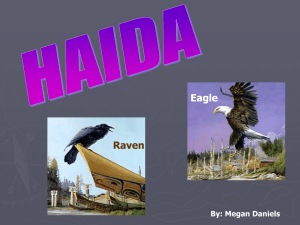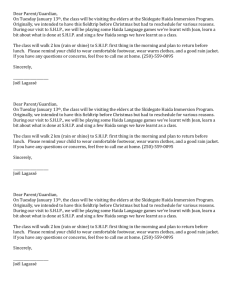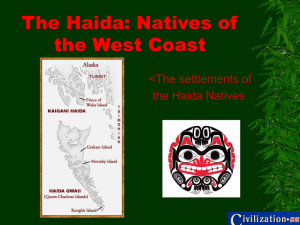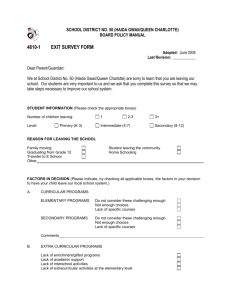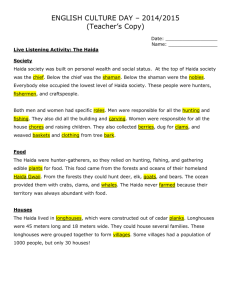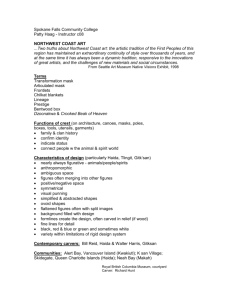Haida of the Pacific West
advertisement
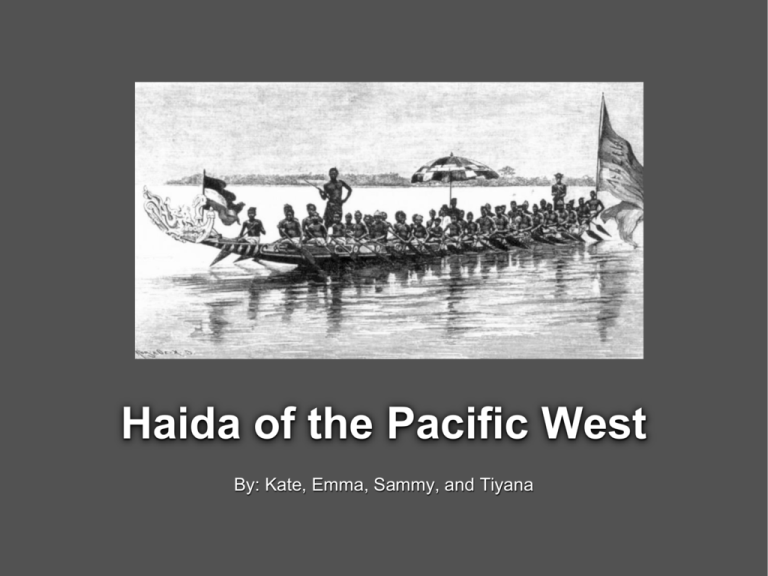
Haida of the Pacific West By: Kate, Emma, Sammy, and Tiyana Biography • Canada has been divided up into six different regions where our current population of First Nations reside. • Northern Forest, Atlantic Coast, Great Lakes, Prairie, Arctic, and Pacific Coast - where the Haida people inhabit. Pacific Coast Region • This region is mostly along the West coast of British Columbia. • This region is covered in tall mountains, lush forests, and wooded valleys. Cutting through the mountains and forests of this region like veins are narrow rivers, and long, thin lakes, which then empty into the Pacific Ocean. • The Pacific Region is one of the richest in natural resources in the world. The land supplied the people with more resources than they needed. Because there were so many ways to survive the native people never had to travel too far to get what they needed. • The people of Haida were rich in culture and art, using the plentiful cedar trees available they would make many complex carvings. Groups of the Pacific West • Along the Pacific Coast, lived the Haida (one of the largest groups), Tsimshian, Tlingit, Kwakiutl, Nootka, Bella Coola, and Coast Salish. • Inland lived the Chilcotin, Carrier, Interior Salish, Tsetsaut, and the Tahltan. The Map • Population: 2,500 (as of 2008) Languages • There are two different dialects of the Haida language; Xaad Kil (Masset), and Xaayadaa Kil Kil (Skidegate) • Both languages are nearly extinct today, with only nine fluent speakers of both dialects, with an additional 13 people who can somewhat understand the language. Work • The Haida are skilled artisans of wood, metal, and design. • The Haida both carved and painted war canoes, made war masks. • They are also the only tribe who actually made totem poles. • The Haida was trade partners with both Russia, Spain, Great Britain, and America. They mostly traded pelts of sea otters and beavers. • Property was owned by lineage - that included things such as salmon streams, trapping sites, edible plants, tobacco fields, bird rookeries, and stretched of coastline. • The Haida enjoyed war, they made large sea-going canoes used to go on raiding expeditions and went as far south as Washington State. Economy Closely related people known as lineage Each lineage had the right to use certain hunting grounds, berry patches, salmon streams, tobacco patches, trapping sites, bird rookeries Most valuable source was salmon Labour was divided, men hunted and fished while women gathered land food Food was in abundance, often times foods were preserved An abundance of natural resources meant that many people were very wealthy and owned many of their own tools Since your place in society was determined by your possessions, the people were sharp traders Captured slaves and they were considered property The more slaves you killed, the wealthier you were considered because you could afford to give up valuable property Politics Each lineage held ranks, titles, crests Some lineages were more important and had higher ranks than others Chiefs inherited titles from their mothers, these men had the right to certain titles like “village owner” Titles/ranks were inherited but you had to prove you were worthy of the title To prove so, chiefs held potlatches A chief invited other chiefs and their relatives to a big party The chief proved his wealth by giving away valuable gifts and large amounts of food Many high ranking individuals from different lineages created secret societies Matriarchal society because although men were the chiefs, there power always came from a woman Diet • They were a hunter-gather society, and relied on hunting, fishing, and gathering edible plants. • Because of this, they did not develop an agricultural system. • To survive the winter, they dried salt-water fish such as pacific salmon. • In the fall, they would travel up rivers to easily catch the spawning salmon. • They went as far as tracking and hunting whales for food (in their war canoe) which took many days to kill, this was also dangerous. • They used seal clubs to knock the animals on their heads, making it easier to trap and kill. • They steamed and boiled indigenous plants, because not even hunters can survive on a meat only diet ;) • Some other animals they would hunt for food were; sea otters, sea turtles, deer, elk, mountain goats, and GRIZZLY BEARS. Inventions/Contributions Used cedar wood to make everyday objects Baskets Clothes Spoons Bowls Bentwood boxes (-steaming wood to bend boxes) Ladles Copper shields Very good at engraving and making Loved art Decorated everyday objects Painting Carving both Totem poles Began late 1700 Found in Alaska and British Columbia Average 3-18 m height Some can be more than 20 Before Europeans around the size of a cane The bottom end of the totem pole is very important Some say it isn’t Many reasons Honour deceased Show the rights acquired in life A time when met up with supernatural being Show the generosity of a sponsor of a Potlatch Only made few 1900 to 1950 Carvings symbolize when the tribe stands for People, animals and supernatural Thunderbird Lord of the sky -grand Respected Fighting own wars Eats whales Attends dance ceremonies Kolus Thunderbird’s bro Dull-witted Show-off Strong Competitive Eagle Lord of the sky Transforms into human dancer Hawk Transforms into human (man/woman) Stand-offish Help humans Raven Trickster Hungry Curious Deviant Politically incorrect Likeable Whale Ruler of underwater Turns into wolves Wolves Avoids humans most times Powerful; Can heal sickness Costly Pure white means powerful Frog Underestimated Great wealth Survive volcanos Never insult Mosquito Remains of Dzunkwa Female beast Cannibal (ate children) Could never be killed Tricked into a fire Burned for days Ashes became mosquitos Love blood Symbol of the Pacific Native (Alaska and British Columbia) 100 years old Ninstints, British Columbia As old as 1835 Doesn’t need to be painted Similar styles from early settlements in New Zealand and Japan Found in museums all over the world Germany Sweden Australia Britain America Canada 1930’s native art very popular Other native tribe made totem poles Important People Skaay: born 1827, could not read or write, crippled by an injury suffered in middle age, story teller, someone happened to record the stories, Skaay is considered one of the most important people in Haida literature. Cumshewa: important chief of the Haida people, in 1794 he lead an army of warriors in a massacre of the crew of the American vessel “Resolution”. Creation Story • Passed down from generation to generation from word of mouth is how the Haida came to be. Said to have emerged from a giant clam shell on the beach at Rose Spit, Raven helped them - the most powerful creature. • Raven had been wandering along the beach when he could hear some strange noises, appearing to have come from the clam shell. • Looking inside the shell, he saw many, tiny humans, who appeared to be scared of him as well as the big world outside the shell. • Raven managed to coerce the little humans out of the shell to come and play in his new, shiny world Facts There is a children’s television show called “Raven Tales” dedicated to teaching kids about the Haida culture. • After the arrival of European peoples, smallpox was the primary ailment that swept across the Haida nation, decreasing the population from 10,000 to under 1,000. • Originally, the Haida were divided into two groups, or 'moieties‘ - the Ravens and the Eagles which were named after their village locations. • The Haida used argillite & argillite as their main raw material for carvings. • According to the Haida the Raven gave the idea of living in large houses, stolen from the Beaver. • The Haida’s canoes were made primarily from red cedar and could seat tens of people, especially prevalent in their war canoes. • Works Cited • "Aboriginal People: Northwest Coast." The Canadian Encyclopedia. Web. 8 Feb. 2015. • “Cumshewa.” Slideview. Web. 8 Feb. 2015. • "Haida." The Canadian Encyclopedia. Web. 8 Feb. 2015. • MacLean, Hope. Indians, Inuit, and Métis of Canada. Toronto, Ont.: Gage Pub., 1982. 69, 70. Print. • “Skaay Qquuna Qiighawaay (Of The).” Douglas & Mcintyre. Web. 8 Feb. 2015. • "Haida Art." Canadian Museum of History. Web. 4 Feb. 2015. • <http://www.historymuseum.ca/cmc/exhibitions/aborig/haida/haaindxe.shtml>. • "Totem Poles from the Tlingit and Haida Tribes." Web. 4 Feb. 2015. • <http://members.home.nl/t.overberg1/Totem_Pole.htm>. • "Totem Poles." Indigenous Foundations.arts.ubc.ca. Web. 5 Feb. 2015. • <http://indigenousfoundations.arts.ubc.ca/home/culture/totem-poles.html>. • "Totem Pole." The Canadian Encylopedia. Web. 5 Feb. 2015. • <http://www.thecanadianencyclopedia.ca/en/article/totem-pole/>. • "Totem Pole Basics." Web. 5 Feb. 2015. • <http://users.imag.net/~sry.jkramer/nativetotems/basics.htm>. • "Haida People: Stories." Haida People: Stories. N.p., n.d. Web. 09 Feb. 2015. Haw'aa (thank-you)
